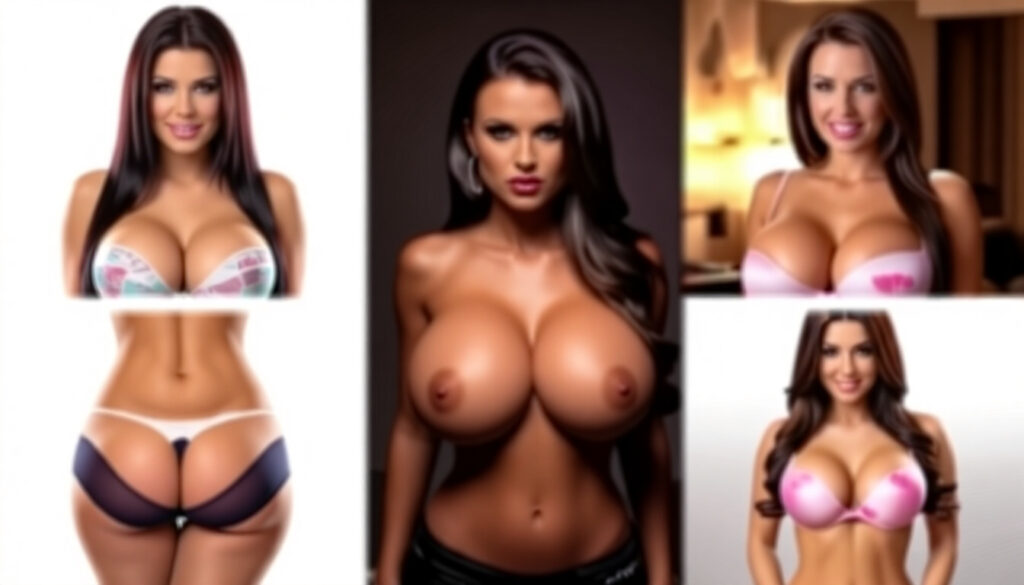There’s something deeply unsettling happening beneath the surface of our most used apps and anonymous chat groups—and it’s not just spam bots or fake profiles. It’s the sharp rise of AI-generated fake nudes, especially those hyper-focused on “fake boobs” and blown-out body proportions designed to attract clicks and fuel digital fantasies. At a glance, these manipulated images might seem like just another product of tech experimentation. But peel back the filter and it’s easy to see what’s really going on: targeted digital violation dressed up as “art.”
Some of these images are full-blown deepfakes, where AI models use real photos to stitch faces onto pornographic content. Others are nudified images—stripped-down versions of innocent photos, manipulated to simulate nudity or exaggerated anatomy with buzzword prompts like “big chest” or “see-through shirt.” It’s not happening in some fringe corner of the internet either. The tools that power this abuse are disturbingly easy to use, often marketed as entertainment. And behind every altered photo is a person whose image was taken—without their consent—and used to stoke a new breed of digital exploitation.
What Are Ai-Generated Fake Porn Images And Why They’re Spreading
There’s a big difference between standard porn online and what AI-generated fake images are doing. These aren’t actors. They’re regular people—most of them women—being stripped digitally through two dominant tactics:
| Type | Description |
|---|---|
| Deepfakes | AI overlays a person’s face onto the body of a porn actor. Built from training data pulled from public photos or videos. |
| Nudification Tools | AI digitally removes clothing from an original image, creating a “naked” version that never existed—but looks real enough to fool someone. |
These images tend to disproportionately focus on exaggerated features like impossibly large breasts, toned abs, or hyper-sexualized poses. Words like “fake boobs” are embedded as image prompts that shape the end result. It doesn’t resemble human sexuality—it resembles a cartoon version created by anonymous online users looking for quick shock value.
Here’s the gut punch: that manipulation isn’t anonymous for the victims. It robs them of consent, of ownership over their image and body. For someone who discovers their likeness altered and spread across porn forums, it’s a deeply personal violation. Whether it’s a high school student targeted by bullies or a well-known Twitch streamer being harassed, the emotional impact hits the same nerve—one that cracks trust, shame, and autonomy in a digital age where no one agreed to have their clothes digitally removed.
The Tech Behind The Violation: How It Works
The mechanics behind these images aren’t from some sci-fi future. They’re already here—and easy to use. AI models like Stable Diffusion, often open-source, allow users to type in what they’d like to see. By mixing realistic photo generators with certain prompts, users can craft near-real pornographic images from something as innocent as a yearbook headshot.
- Prompt injection: Adding terms like “fake boobs,” “underwear transparent,” or “see-through dress” tells AI exactly how to skew the image.
- LoRA (Low-Rank Adaptation) models: Fine-tune image styles for ultra-specific “fantasy figures,” letting users craft repeat violations fast.
Then there are nudification platforms—often pop-up web tools or Discord bots—that claim to “reveal” what someone looks like under their clothes. These services are priced per image, sometimes powered by tokenized payments, and advertised in fringe forums. While they pretend to lean toward curiosity or entertainment, most of the marketing language targets revenge, humiliation, or fantasy fulfillment.
The real danger? This content can move from a chat server into full-blown porn distribution chains within hours. Users take a fake image and anonymously upload it to adult sites. Some even add fake names, tag the victim, or leave enough breadcrumbs to make the person easily searchable. It blurs the line between a joke and abuse—and for the person whose face is on that photo, the damage is already locked in and multiplied with every share.
Why This Isn’t Just Code: Deep Psychological And Real-Life Effects
This isn’t just about code gone rogue. Something deeply human—trust, identity, dignity—is being hijacked. When someone finds out their face or body has been manipulated and distributed without consent, the blow goes deeper than a privacy issue. It’s a gutting loss of control, especially when victims see themselves sexualized in ways they never agreed to. The emotional fallout is sharp, long-lasting, and often completely hidden from the real people sharing, clicking, or laughing in comment threads.
What’s worse is who this wave of AI abuse hits hardest. Women, especially younger girls and influencers, are being disproportionately targeted. Their selfies, livestream clips, or even school photos are used without permission—warped into something hyper-sexualized, then ranked or commented on like props in a game. The ripple effect spreads beyond personal trauma. Seeing these “perfected” bodies—clearly unreal, but scarily believable—feeds toxic beauty standards for everyone, making people question if their real, untouched body is enough.
For some, it doesn’t end with image theft. There have been growing incidents tied to harassment, blackmail, and catfishing scams where fake nudes are circulated with threats unless money or more photos are sent in return. Criminals use these AI images to impersonate people, attack reputations, or exploit relationship trust. And while victims speak out, many legal systems are still slow to catch up. Reporting yields few results. Takedowns take time. By then, the damage is already done.
This isn’t about protecting image quality. It’s about protecting people—especially from tech that, when turned toward harm, leaves devastating emotional wreckage that’s hard to trace and harder to erase.
Where These Fakes Are Circulating and Why We’re Not Seeing It Sooner
Scroll Reddit long enough, and you’ll trip over a thread hinting at “NSFW transformations.” Dive deeper, and suddenly you’re neck-deep in Telegram groups and oddly named Discord servers where words like “nudify,” “AI peel,” or “skin swap” bounce around. These spaces aren’t just digital basements—they’re active, ever-morphing hideouts built to avoid bans and fly under the radar.
Most platforms are gamed with euphemisms. Instead of outright saying “deepfake porn,” users opt for terms like “bikini reversal” or “SFW2NSFW.” Algorithms—too rigid or too relaxed—miss the nuance. Traces of these manipulated images pop up without warning across community-driven apps, rarely getting flagged in time.
One reason it’s not raising more red flags? The language makes it sound harmless. “It’s just art,” someone comments under a Reddit post. “AI made it, not me.” The detachment is intentional—if it’s synthetic, it must be victimless, right? But detaching humanity from the image doesn’t erase the target.
Then there’s porn search traffic. A quiet storm is brewing behind keywords like “AI fake boobs” or “generated nudes.” Streaming sites are catching on, not by removing the content, but promoting it. It’s trending, so it sells. Some of these platforms even use AI content tags to boost engagement—even if the content violates their supposed ethical guidelines.
Who’s Fighting Back: Laws, Detection Tools, and Public Resistance
Not everyone’s running from the issue—some are fighting head-on. The U.S. is drafting new laws aimed at outlawing non-consensual deepfake porn. These bills tackle the digital violation of sexual content made without consent, often coined “deepfake revenge porn.” Over in the EU, lawmakers are considering tighter rules to protect digital identity integrity—crucial when someone’s face can be AI-pasted anywhere.
On the tech front, detection is slow—but not nonexistent. Tools built around forensic analysis, like visible watermark tracing or reverse image matching, are emerging. Then you’ve got antibody-style AI models trained to recognize tampered pixels. Still, these tools are patchy at best. Like the world’s worst game of digital whack-a-mole, new methods pop up before one gets squashed.
But it’s not just top-down intervention that matters. Communities are pushing back too. High schools are sounding alarms—not about sexting, but AI-generated “nudes” of students made using school photos. Feminist collectives online are leading education drives, calling out platforms and spreading instructions on how to flag violations efficiently. Even some porn platforms, under enough heat, have begun purging AI-tagged content entirely from certain categories.
Accountability and Where Things Are Falling Short
A glaring issue? Social media companies love to play the “fantasy art” card. Even when users flag explicit AI-generated images of real people, platforms shrug—claiming it’s not violating any guidelines because the image is “technically fake.” That label offers a loophole wide enough to drive digital harm through.
Sites that monetize AI fantasies often slap on vague disclaimers like “all characters are fictional,” as if that cushions impact. Sometimes, the victim isn’t even aware they’ve been turned into a product for strangers’ consumption until the damage is already viral.
So who’s to blame? You’ve got prompt engineers who enter cringe-level specific commands like “girl in red dress, pulled down, bedroom lighting.” You’ve got creators who train AI on stolen private photos or screenshots. Then there’s the platforms—these tools don’t spread themselves. Somewhere, someone approves, hosts, or turns it into coin.
Saying “it’s not real” is a lie the internet tells itself to cope. But the mental harm, the chaos it introduces into someone’s life—that’s as real as bruises. And digital space doesn’t erase the need for consent. Just because the pixels were tweaked doesn’t mean someone gave permission to be reimagined that way.








